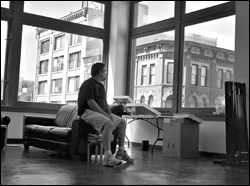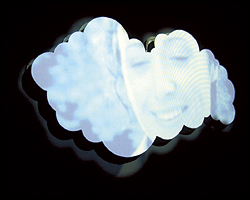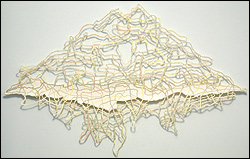Pioneer Square will see some changes in the next few months, and none of them involves AstroTurf.
Three established galleries—Howard House, Garde Rail, and Soil—are moving to Pioneer Square from other parts of town. More may follow, and at least one new gallery is about to launch in the neighborhood. Several factors are responsible, but a key catalyst is the opening last month of the Tashiro/Kaplan project at Third Avenue and Yesler Way, which offers affordable gallery space and 50 rent-controlled artists’ lofts. Pioneer Square’s visual arts community is getting a much-needed shot of adrenaline, one that promises to shake up the popular but generally stodgy First Thursday gallery scene.
As for the AstroTurf, that mind-bogglingly bad idea came courtesy of the New York nonprofit Project for Public Spaces, which was recently paid $40,000 by the city to help revitalize Occidental Park. Seems the place would be improved if only those pesky trees, totem poles, and cobblestones were replaced with plastic grass. But regardless of what happens to Occidental, local artists and gallery owners are involved in a revita‑ lization project of their own—one that’s more firmly rooted here on planet Earth.
The trend began last month when Billy Howard moved Howard House, a nationally recognized venue with a talented corps of emerging artists, from Belltown to a roomier space on Second Avenue near James Street.
But it’s the Tashiro/Kaplan project that’s really driving the influx of artists and galleries. Developed by the Minneapolis-based nonprofit Artspace in cooperation with the city, T/K is meant to address the loss of some 250 artists’ studios in Pioneer Square over the past five years, thanks to gentrification and damage from the Nisqually earthquake.
Artspace regional director Cathryn Vandenbrink, a jewelry artist turned patron saint of struggling artists, was the driving force behind the project, which raised just under a million dollars in foundation grants to make things happen. “The whole sensibility of the project was to protect space for creative people,” said Vandenbrink. Not limited to visual artists, the tenants (who are subjected to a not-too-rigorous peer review) include painters, photographers, dancers, actors, writers, and musicians. All 50 spots are now leased.
Although the commercial space isn’t subsidized, it’s being offered at very reasonable rates. T/K’s 15-year leases have proven irresistible to several galleries. Garde Rail, the outsider/folk art gallery currently in Columbia City, will pack its bags for T/K, as will Soil, an artists’ cooperative gallery with a longtime presence on Capitol Hill. In addition, Forgotten Works, an alternative gallery in a creaky Pioneer Square building under threat of demolition, will also take up residence. The county’s 4Culture public arts program and gallery is exploring a move to T/K, although 4Culture’s executive director, Jim Kelly, confided that plummeting prices for commercial real estate might prompt 4Culture to stay in its current Smith Tower location.
The T/K project has also inspired a group of four local artists to create their own commercial gallery.
Dirk Park, a photographer who rents a loft in T/K, called Vandenbrink and several other artists to see if he might create a different kind of gallery space. “I wanted a somewhat different model from what you see in Seattle,” Park says. “We were looking at galleries in San Francisco, New York, and L.A. and wanted something that wasn’t so focused on a small group of artists.”
The four partners in Platform Gallery, as it will be known, are Park, multidisciplinary artist Carol Bolt, painter Blake Haygood, and sculptor and installation artist Stephen Lyons. The group hopes to bring in more than just regional artists, which much of Seattle’s provincial art scene often limits itself to. Platform is scheduled to open in September with a show of avant-garde taxidermy by Portland artist Carlee Fernandez and L.A.’s Keith Yurdana.
Park sees Platform as a part of Pioneer Square’s artistic transformation. “With all these galleries coming in,” he says, “I definitely think we’ll see a big shift to contemporary and emerging artists on Second and Third alongside Kucera and James Harris”—two Pioneer Square galleries with reputations for cutting-edge work.
Park hopes he’ll still have time to practice his art while managing a newborn gallery. Having rent-controlled loft space will help: Since moving to T/K, his personal rent expenses have been cut in half. “It’ll take up a fair amount of my time, but my economic needs have really decreased. It’s a dream situation.”
This kind of support is heartening for local artists, but much still needs to be done. According to Vandenbrink, Artspace is investigating other potential spaces, including the Hiawatha Village project near Seattle’s Goodwill. Artspace also developed two smaller-scale low-income artist projects in the Wallingford Good Shepherd center and the Harbor Lofts at Second Avenue and Yesler Way. Vandenbrink has heard the rumors that part of the old Rainier brewery now operated by Tully’s might be converted to affordable space by a private company, but she’s not holding her breath.
“This is not easy work to do, creating low-income housing,” she says.
Meanwhile, Dirk Park relishes the oppor‑ tunity to live and work downtown. “I feel like I’m a part of the city,” he says. “There are so many visually interesting things going on.” He’s able to observe the flow of life in the city by walking the streets at night or simply gazing out the nearly floor-to-ceiling windows.
“It’s like living in a tree house.”







